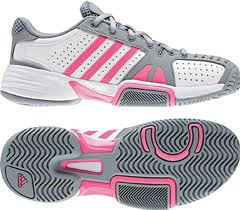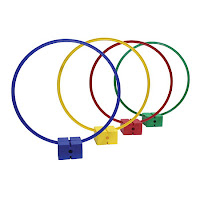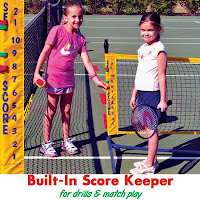As a 10 and Under Tennis specialist, many of my students have never set foot on a tennis court before our first meeting. Their parents often ask me what the player needs to bring. Unlike some sports such as hockey and football, our needs are simple. The absolute must-haves are 1) shoes and 2) racquet. Do the math and you will see that I have eight other items I find extremely useful for the junior beginner tennis experience. Push comes to shove, those two will do.
 |
Look for the reinforced sole
at the ball of the foot below
the big toe |
Shoes
It is extremely important for safety reasons that your player's shoes are athletic/sneakers. It is important for the maintenance of our facilities that they are the non-marking variety. Most kids have sneakers, and many of these are running shoes. That's okay but they do sometimes tend to be a little too grippy on hard courts. So if your child is going to get serious about tennis, at some point you might want to consider getting them some true tennis shoes. You want the sole of the shoe to match the surface they will be playing on. Generally speaking this is a court shoe. If your facility has clay courts, they do make clay court-specific shoes. Encourage your player to save the tennis sneaks for tennis and wear the non-tennis shoes for other stuff - school, errands, etc.
Racquet
Tennis, like most sports, is evolving and taking advantage of many technological updates. One big change is multiple racquet sizes for juniors. They now come in 19, 21, 23 and 25 inch lengths (adult racquets start at 27 inches). If this is your child's first experience with tennis it is extremely important the racquet fit the child, especially if the child is 10 or younger. Today's racquets are lighter and smaller and generally designed to fit the height of your child. Read the label carefully before you buy. Resist the urge to dust off that wooden Pancho Gonzales antique you rescued from your granny's garage sale. :)
That's the two items you just can't do without. The following are more items your player will find useful. Have I overlooked anything?
Pockets
 |
Are you the right demographic
for this item?? |
For boys and girls, it is so important to have a place to stash an extra tennis ball or two, especially when you start playing in tournaments and no coach is there with a cart full of balls, tossing you one whenever you need it. I have been to too many introductory events where inordinate amounts of time are wasted during a match because players don't have pockets and are moseying all over the court after every point to retrieve balls for serve. For the love of all that is holy, please acquire some shorts with pockets for your player. For the girls, if they are into the tennis attire, good news - the little undershorts under most tennis skirts are stretchy and designed for you to be able to tuck a ball there and actually have it stay there while you are running around on the court - very convenient! If that is not an option there are also little inexpensive plastic ball holders that clip onto the waistband of your shorts. Fair warning: I have never seen anyone under age 40 use one of these things. I have never seen a male of any age use one. You have been warned.
Hat
Most of my new students come out without any type of head covering or shade apparatus. I realize this is a matter of personal preference. Since I live and teach in the south, I consider a hat a matter of self-preservation. Shading the eyes and head is just common sense. For players with lots of hair, hats are a twofer - they shade your eyes
and keep your hair out of your face. Sunglasses may better suit your player. I suggest tossing a hat or visor in your bag JIC - Just In Case!
Bag
Speaking of bags - once my students start getting serious about tennis, they find they are accumulating lots of items to lug to the lesson, and a bag becomes very handy. It doesn't have to be fancy. It doesn't have to be new. But having a bag for all the tennis stuff helps everyone stay organized and helps prevent that uh-oh moment when you arrive at your tennis lesson and realize you left your racquet at home. Also, it eases the transition from Mom/Dad lugging all the tennis stuff to the students being responsible for all their tennis stuff! If you are interested in a tennis-specific bag, there are lots of them out there. Find one you like online, then Google like crazy to find the best deal.
Water Bottle
Many facilities have water on the courts, but not all. Even if they do have water on court, bringing your own water bottle to refill is the green thing to do.
Towel
This is a personal preference because I am a sweat hog and I use a towel frequently when teaching, never mind when playing. Most people have a perfectly suitable hand towel lying about at home with nothing better to do. Put it in the bag!
Sunscreen
Because I live in South Carolina. Enough said.
Bug Spray
Because I live in South Carolina. Enough said.
Snack
Not usually needed for a 45-60 minute lesson, but definitely handy when your player starts playing tournaments. Average match lasts 1.5 hours; some can go longer, and your player will likely play more than one match per day. More about proper nutrition for competition in
another blog post.
























